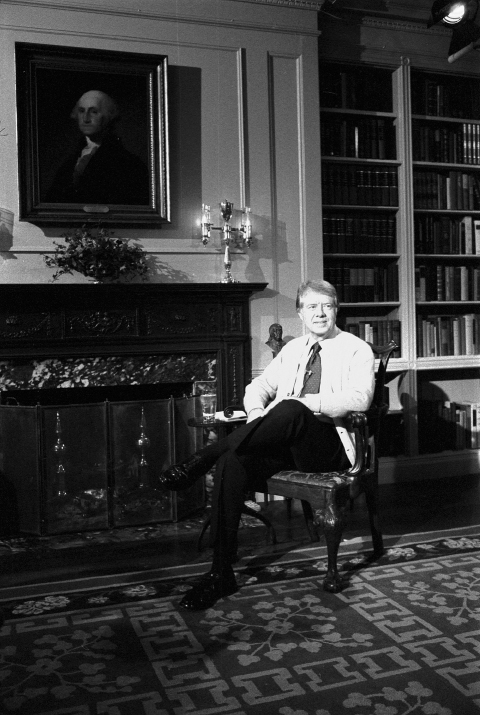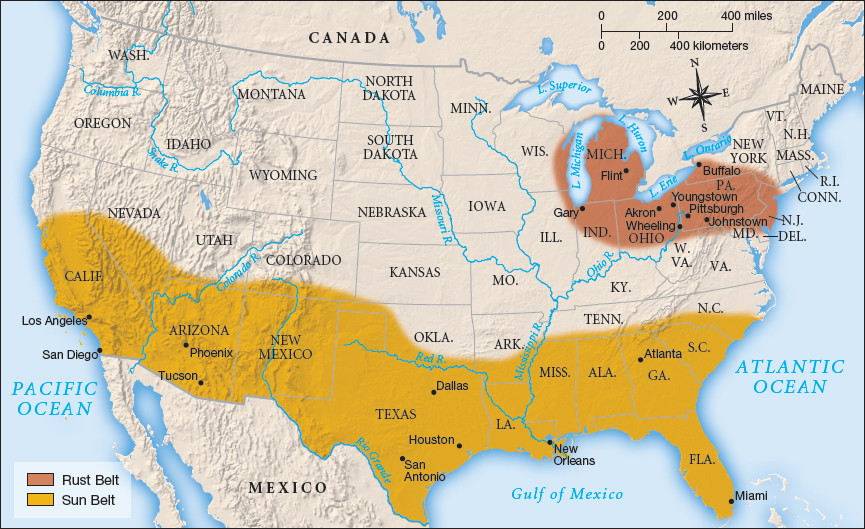Jimmy Carter and the Limits of Affluence

Despite his political shortcomings, Gerald Ford received the Republican presidential nomination in 1976 and ran against James Earl (Jimmy) Carter, a little-known former governor of Georgia, who used his “outsider” status to his advantage. Shaping his campaign with Watergate in mind, Carter stressed character over economic issues and promised voters that he would run the government honestly, truthfully, and morally. As a postsegregationist governor of Georgia, Carter won the support of the family of Martin Luther King Jr. and other black leaders. Carter needed all the help he could get and eked out a narrow victory.
The greatest challenge Carter faced once in office was a faltering economy. America’s consumer-oriented economy depended on cheap energy, a substantial portion of which came from sources outside the United States. By the 1970s, four-fifths of the world’s oil supply came from Saudi Arabia, Iran, Iraq, and Kuwait, all members of OPEC. The organization had been formed in 1960 by these Persian Gulf countries together with Venezuela, and it used its control of petroleum supplies to set world prices. By the time Carter became president, the cost of a barrel of oil had jumped to around $30. American drivers who had paid 30 cents a gallon for gas in 1970 paid more than four times that amount ten years later.
Energy concerns helped reshape American industry. With energy prices rising, American manufacturers sought ways to reduce costs by moving their factories to Mexico, Central and South America, and several Asian nations that offered cheaper labor and lower energy costs. This outmigration of American manufacturing had two significant consequences. First, it weakened the American labor movement, particularly in heavy industry. In the 1970s, union membership dropped from 28 to 23 percent of the workforce and continued to decline over the next decade. Second, this process of deindustrialization accelerated a significant population shift that had begun during World War II from the old industrial areas of the Northeast and the Midwest (the Rust Belt) to the South and the Southwest (the Sun Belt), where cheaper costs and lower wages were enormously attractive to businesses (Map 27.2). Only 14 percent of southern workers were unionized in a region with a long history of opposition to labor organizing. The North’s loss was the South’s gain, and cities such as Houston, Texas; Atlanta, Georgia; Phoenix, Arizona; and San Diego, California, flourished, while the steel and auto towns of Youngstown, Ohio; Flint, Michigan; and Johnstown, Pennsylvania, decayed.

These monumental shifts in the American economy produced widespread pain. Higher gasoline prices affected all businesses that relied on energy, leading to serious inflation. Between 1974 and 1980, housing prices more than doubled, and the average cost of a new car jumped from $3,900 to $5,770. To maintain their standard of living in the face of rising inflation and stagnant wages, many Americans went into debt, using a new innovation, the credit card, to borrow more than $300 billion. The American economy had gone through inflationary spirals before, but they were usually accompanied by high employment, with wages helping to drive up prices. In the 1970s, however, rising prices were accompanied by growing unemployment, a situation that economists called “stagflation.” Joblessness had risen to 9 percent on the eve of Carter’s election and stood at 7 percent when he ran for reelection in 1980. Traditionally, remedies to control inflation increased unemployment, yet most unemployment cures also spurred inflation. With both occurring at the same time, economists were confounded, and many Americans felt they had lost control over their economy. In 1978, 55 percent of survey respondents declared, “Next year will be worse than this year.”
President Carter had no better solutions than did his predecessor. To reduce dependency on foreign oil, in 1977 Carter devised a plan for energy self-sufficiency, which he called the “moral equivalent of war.” Critics poked fun at the proposal by reducing the president’s words to the acronym MEOW, suggesting that it had all the bite of a pussycat. A more substantial accomplishment came on August 4, 1977, when Carter signed into law the creation of the Department of Energy, with responsibilities covering research, development, and conservation of energy.